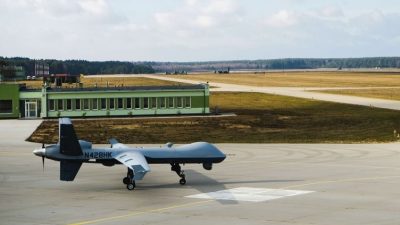Romania Willingly Becomes a U.S. Drone Base Aimed Against Russia

The already existing tensions in the Black Sea region have heightened because of the Defender-Europe 2020 exercises, which include ten participating states, including the Black Sea state of Romania. Through these U.S.-led exercises, that are mostly aimed against Russia’s Kaliningrad enclave in the Baltics , the U.S.-made MQ-9 Reaper reconnaissance and assault drones, made infamous for being used in the assassination of Iranian Lieutenant General Qassem Soleimani earlier this month, were deployed in Romania.
The presence of the Pentagon’s and CIA’s strategic squadron on the Black Sea and close to Russia does not contribute in any way to maintaining regional security, and rather these offensive weapons that were used in the assassination of high-ranking officials of enemy countries, aims to pressurize Russia further. The deployment of such drones in Romania shows that the former Warsaw Pact country is willingly going beyond its NATO responsibilities by becoming a critical staging point for anti-Russian pressure.
Moscow has mentioned on several occasions that it would consider these assault drones to be the equivalent of medium-range missiles, banned by the Intermediate-Range Nuclear Forces Treaty. Despite this warning, it had done little to influence the decision of Warsaw to permanently host the drones at the Mirosławiec airbase in western Poland.
The Romanian airbase Câmpia Turzii is the host of these offensive weapons. Although in the event of a military conflict in the Black Sea region, Russian anti-aircraft and missile defense units could intercept and destroy unmanned targets, even those in take-off position, this move to host offensive U.S.-made weapons is part of a larger strategy to pressurize, isolate and contain Russia in the Black Sea. Romania is not the only anti-Russian state on the Black Sea – Bulgaria and Turkey are also NATO members, and Ukraine and Georgia are weaponized states with aspirations of joining NATO. The U.S. are effectively leading efforts for a coalition against Russia in the Black Sea, even though it is unlikely that these states have the combined power to challenge Russian naval and aerial dominance in the region.
The U.S. Air Force Command in Europe announced that the MQ-9 Reaper drones will be relocated to Romania until spring to support a series of operations, gathering information, monitoring and air reconnaissance in the Black Sea area. These drones can fly a distance of 6,000 kilometers, a distance that can comfortably cover Moscow, St. Petersburg and even the western fringes of Siberia. This is a dangerous prospect for Russia considering that these drones are capable of not only carrying out assassinations, but can also carry a nuclear warhead. The drones have been used to deadly effect in Iraq and Afghanistan where it has begun replacing piloted F-16 and A-10 flights by the U.S. air force.
The Pentagon has invested $3 million in the construction on a hangar and other sites in Romania for the deadly drones. These facts confirm the existence of long-term plans to use the Câmpia Turzii air base as an aerodrome for sending American drones to strategic targets in Eastern Europe when need be, all with the aim of pressuring Russia.
The Defender-Europe 2020 exercises primarily aims to put pressure on Kaliningrad, but the deployment of these drones has now demonstrated that it is a multipronged exercise against Russia that has expanded the focus of operations. Effectively the Defender-Europe 2020 exercises stretches from the Baltic Sea to the Black Sea, in a show of force to demonstrate to Russia that any war with NATO will be conducted across two seas and the entirety of its European land border with the exception of perhaps Finland.
This move to turn Romania into a U.S. drone base against Russia has wider aspirations for some leading thinkers in Washington. Moldova, a neighobring Romanian-speaking country, has been identified by the highly influential RAND think tank to become another U.S. military hub on the Black Sea. This identification of Moldova also comes as the U.S. military base network is expanding in Romania with the arrival of 500 U.S. servicemen in order to strengthen the Kogâlniceanu air base. Chisinau has cooperated with NATO allies and partner states for several years through the Partnership for Peace and the Euro-Atlantic Partnership Council. Moldova also bought weapons in 2018 in accordance to the Alliance’s standards. However, the Moldovan Constitution ensures that the country is a neutral state, and according to the polls, the majority of the population is against NATO membership. Although RAND has identified Moldova to become a hub for the U.S. military, this will unlikely occur, essentially meaning Washington’s policymakers are concentrating on further militarizing Romania against Russia.
Although Romania is consolidating its position in the anti-Russian bloc, the drones do cause a matter of concern, but perhaps not seriously enough as Russia will have confidence in its own air defense capabilities, especially with the famed S-400 missile defense system. This still does not deter the fact that Romania is willingly becoming a hub for the U.S. military to oppose Russia.
*
Note to readers: please click the share buttons above or below. Forward this article to your email lists. Crosspost on your blog site, internet forums. etc.
This article was originally published on InfoBrics.
Paul Antonopoulos is a Research Fellow at the Center for Syncretic Studies.
Featured image is from InfoBrics

